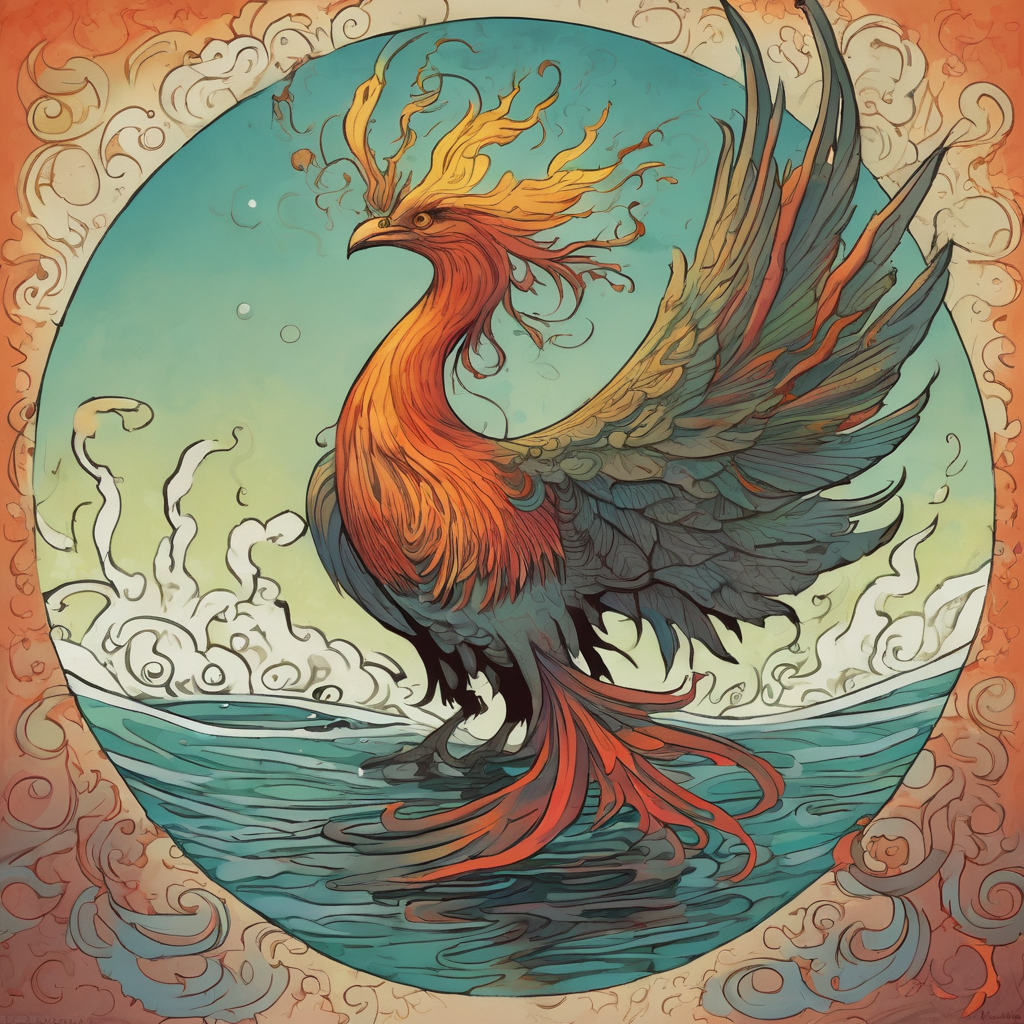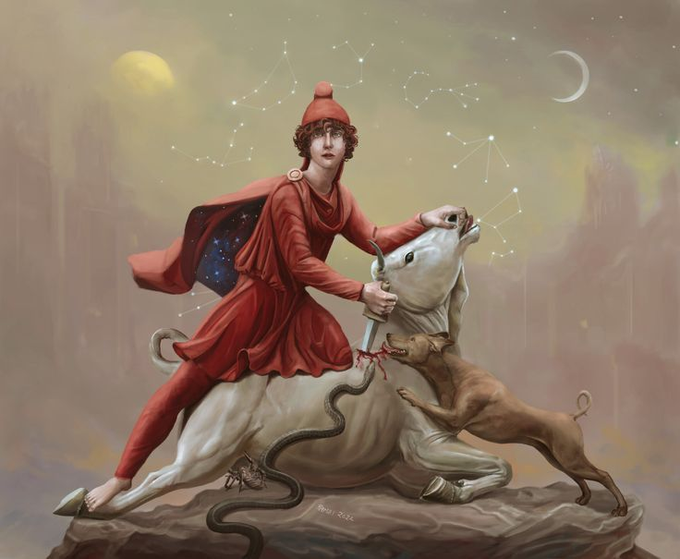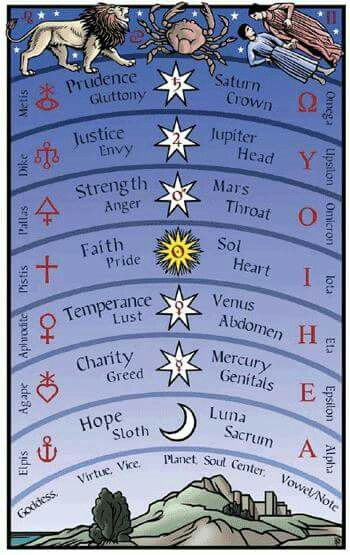
Hermetic cosmological systems:
Primum Mobile (One)
The Sphere of the Fixed Stars
The Sphere of Saturn
The Sphere of Jupiter
The Sphere of Mars
The Sphere of the Sun
The Sphere of Venus
The Sphere of Mercury
The Sphere of the Moon
The Terrestrial Sphere
The cult of Mithra that was prevalent in the Roman Empire had its origins in Persian/Zoroastrian religious beliefs, The bull was associated with the constellation Taurus, which was believed to be the source of life and fertility.
The hierarchical structure of the Mithraic cult
Corax (Raven) - purification
Nymphus (Bride) - fertility
Miles (Soldier) - warrior class
Leo (Lion) - sun and fire
Perses (Persian) - origins
Heliodromus (Sun-runner) - solar rituals
Pater (Father) - presided over the cult

Vedic Astrology (Jyotish) is considered one of the six ancient Vedic sciences, The primary texts that form the foundation of Vedic Astrology include the Vedas, the Upanishads, the Puranas, and specialized astrological treatises like the Brihat Parashara Hora Shastra.
The nine major planets or celestial bodies (Navagraha) that are central to Vedic Astrology Sun (Surya) Moon (Chandra) Mars (Mangala) Mercury (Budha) Jupiter (Guru) Venus (Shukra) Saturn (Shani) Rahu (North Lunar Node) Ketu (South Lunar Node) Kundali = individual's birth chart
Zurvanism (around the 3rd-4th centuries CE) incorporated the idea of Zurvan as the ultimate source of both Ahura Mazda (the good, supreme deity) and Ahriman (the evil, destructive force), creating a more monistic and deterministic interpretation of Zoroastrian dualism.
Manichaeism was a Gnostic, dualistic religion founded by the Persian prophet Mani (216-276 CE). It incorporated elements from Zoroastrianism, Christianity, Buddhism, and other ancient Middle Eastern belief systems.
According to the Gnostic text Pistis Sophia, the Archons employ various strategies and mechanisms to try and imprison the human soul and prevent its spiritual ascension. Rulership over the Celestial Spheres False Beliefs, Fear Erasure of Memory Reincarnation and Entrapment
In the Pistis Sophia, The Moon is described as a kind of gatekeeper or checkpoint through which the soul must pass during its ascent after death. The Archons that dwell on the Moon attempt to prevent the soul from progressing further on its journey.
Phoenician Civilization (1200 BC - 300 BC)
Classical Greek Civilization (800 BC - 323 BC)
Neo-Assyrian Empire (911 BC - 609 BC)
Etruscan Civilization (800 BC - 100 BC)
Neo-Babylonian Empire (626 BC - 539 BC)
Persian Achaemenid Empire (550 BC - 330 BC)
Hittite Empire (Turkey)
Mycenaean civilization (Greece)
Cypriot civilization (Cyprus)
Canaanite city-states (Levant)
Egyptian New Kingdom Ugarit (Syria)
Mesopotamian civilizations (Assyria, Babylon, etc.)
Minoan civilization (Crete)
The Hermetic Tradition, believed that the human soul possesses a divine spark of knowledge that can be "awakened" or "remembered" through esoteric practices and contemplation.
The Vedas and Upanishads, posit the idea of Atman (the individual soul) as being inherently connected to the universal Brahman (the divine, ultimate reality). The process of self-realization is often described as the "remembering" or recognition of unity within oneself.
In Hindu cosmology, as depicted in the Mahabharata, the seven celestial spheres or "lokas" Bhuloka (Earth) Bhuvarloka (Atmospheric) Svarloka (Celestial) Maharloka (the Great) Janarloka (Realized Souls) Tapoloka (Austerities) Satyaloka (Truth)
The Trimurti: Brahma, Vishnu, and Shiva - represent the three essential functions of creation, preservation, and transformation/destruction, respectively. These three aspects are seen as a unified, interdependent whole, reflecting the cyclical nature of existence.
These personifications of the planets are deeply rooted in Hindu astrology, mythology, and philosophy. Sun (Surya) Moon (Chandra) Mars (Mangala) Mercury (Budha) Jupiter (Brihaspati) Venus (Shukra) Saturn (Shani)
The vertical line of the Ankh symbolizes the masculine principle, while the loop at the top represents the feminine principle. cardinal directions (north, south, east, west) classical elements - earth, air, fire, and water. seasons and cycles of life
When these two elements are combined, they form the complete Ankh, signifying the sacred union of the masculine and feminine. This unification of opposites is a fundamental theme in Egyptian cosmology, where the divine is seen as the marriage of male and female energies.
Thumb - Planet: Venus
Index Finger - Planet: Jupiter
Middle Finger - Planet: Saturn
Ring Finger - Planet: Sun
Little Finger - Planet: Mercury
The three sections of each finger represent the 12 zodiac signs: All 5 fingers - 15 days waxing and 15 days waning of the moon.
Earth Hand: Sq palm w/ short, thick fingers
Air Hand: Long, thin fingers w/ sq or rec palm
Fire Hand: Conical fingers w/ sq or long palm
Water Hand: Oval palm w/ long, tapering fingers
Mixed Hand: A combination of the above characteristics
12 Olympian | Greek pantheon
Zeus - Sky, Thunder (Jupiter)
Hera - Marriage, Women (Juno)
Poseidon - Sea, Earthquakes (Neptune)
Demeter - Agriculture, Fertility (Ceres)
Ares - War (Mars)
Athena - Wisdom, Courage, Law, Justice (Pallas)
Apollo - Music, Poetry (Sol/Sun)
Artemis - Hunt, Chastity (Luna/Moon)
Hephaestus - Blacksmiths, Artisans (Vulcan)
Aphrodite -Love, Beauty (Venus)
Hermes - Trade, Travelers (Mercury)
Dionysus - Wine, Vegetation (Bacchus)
12 major deities of the Sumerian pantheon
Anu - Heavens (Uranus)
Enlil - Air/Wind (Jupiter)
Enki - Waters (Neptune)
Ninhursag - Earth (Earth)
Nanna/Sin - Moon (Luna/Moon)
Utu/Shamash - Sun (Sol/Sun)
Inanna/Ishtar - Love, Beauty (Venus)
Ninurta - Agriculture, War, (Mars)
Ereškigal - Underworld (Pluto)
Dumuzid/Tammuz - Shepherds (Mercury)
Girra/Gibil - Fire (Saturn)
Niŋirsu - Fertility, War (Titan/Titan)
The 7 Metals
Gold - Sun
Silver - Moon
Iron - Mars
Mercury - Mercury
Tin - Jupiter
Copper - Venus
Lead - Saturn
The 7 Alchemical Stages
Calcination - Mars
Dissolution - Moon
Separation - Mercury
Conjunction - Sun
Fermentation - Jupiter
Distillation - Saturn
Coagulation - Venus
Cardiovascular System - Sun
Respiratory System - Moon
Digestive System - Mercury
Urinary System - Jupiter
Nervous System - Saturn
Endocrine System - Venus
Musculoskeletal System - Mars

In ancient Chinese cosmology, the seven luminaries were associated with gods/goddesses like Chang'e (Moon), Ri (Sun), Tao (Mercury), Xingxing (Venus), Yinghua (Mars), Muxing (Jupiter), and Doumu (Saturn).
In ancient Hindu astrology, the grahas (planets) were equated with deities like Chandra (Moon), Surya (Sun), Budha (Mercury), Shukra (Venus), Mangala (Mars), Brihaspati (Jupiter), and Shani (Saturn).
In ancient Greek/Roman traditions, the seven planets were connected to gods like Selene (Moon), Helios (Sun), Hermes (Mercury), Aphrodite (Venus), Ares (Mars), Zeus/Jupiter, and Cronus/Saturn.
In Mesopotamian/Babylonian mythology, the seven planets were linked to deities like Sin (Moon), Shamash (Sun), Ishtar (Venus), Nergal (Mars), Marduk (Jupiter), and Ninurta (Saturn).
Mayan gods with the 7 planets, Aztec equivalents: K'inich Ajaw - Sun / Tonatiuh Ix Chel - Moon / Coyolxauhqui Xbalanque - Mercury / Quetzalcoatl Chac - Venus / Tlaloc Ah Puch - Mars / Huitzilopochtli Juun Ajaw - Jupiter / Tezcatlipoca Kawil - Saturn / Xiuhtecuhtli
Comments
Post a Comment